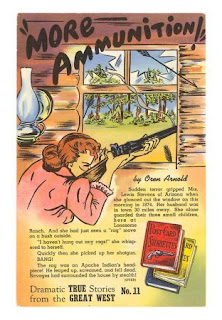 More Ammunition, Ad for Western Pulp from Art.com
More Ammunition, Ad for Western Pulp from Art.com
If you want to learn how to create tension throughout an entire story, then I suggest you watch this movie. It’s based on an Elmore Leonard short and he is the master of “anything goes.” Mr. Leonard has no sentimental attachments to his characters and as such, when you start one of his books you get the sneaking suspension that someone important might not make it to the end. His characters – heroes and heavies, equally – are capable of anything. Anyone could buy it at any moment and when they do, it’s just like death in real life – unrelenting and final.
One of my favorite death scenes in literature is at the end of Out of Sight – the book, not the movie – when a lovable secondary character dies. My second is when Jay Gatsby is shot in his pool. And when I say favorite, I don’t mean that I have a thing for death scenes. I mean that they’re so effective, they make you gasp and then at random moments, long after you’ve finished the book, you can still remember how you flinched and then reread the scene to make sure the author really killed that guy off.
The key to this idea of “anything goes” – for me – is to think of my readers as the other character riding along with the story. I’m usually into the third or fourth draft when I invite them in because at that point I know my characters and what they’re capable of doing. So when I let the reader in, I think of that person sitting there with the book in her hands and then ask myself, “how do I get a reaction out of her?” What does she expect and what can I do to turn that expectation around on her?
Donald Maas has a chapter in his book, Writing the Breakout Novel in which you take your character and then think of a bad thing that you could inflict on them. And then something slightly worse. And then something even worse than that until you bring them to the impassable obstacle that would make then turn around and give up the goal.
It is exhausting, frustrating work. When I did it with Switchcraft, the process nearly made me give up. But when I think of what I did to my girls, Aggie and Nely and the emails I got from readers reacting to those final scenes, it was worth it.
